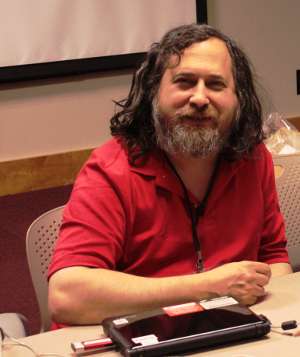
June 26, 2013
Today Free Software Foundation founder and president Richard Stallman was inducted into the 2013 Internet Hall of Fame!
He joins other visionaries like Aaron Swartz, Jimmy Wales, and John Perry Barlow, who have all made significant contributions to the advancement of the global Internet. The Internet Hall of Fame inducted Stallman for his contributions as creator of the GNU Project, main author of the GNU General Public License, and his philosophical contributions as founder of the free software movement. Richard has been named an Innovator, a category which recognizes and celebrates individuals who made outstanding technological, commercial, or policy advances and helped to expand the Internet's reach.
The future of a troubled Internet was on Richard's mind as he learned of his induction. He says, "Now that we have made the Internet work, the next task is to stop it from being a platform for massive surveillance, and make it work in a way that respects human rights, including privacy."
We at the FSF are working hard to stop NSA surveillance, protect the free Internet from DRM, and develop replacements for network services that spy on their users, but we need your support to achieve these goals.
Help us further this vision by becoming a member of the Free Software Foundation or volunteering today.
Nearly 30 years after he first published the GNU Manifesto (stay tuned for coming September celebration plans), Richard Stallman's ideas have spread the world over. Thanks to the support of people like you, the free software movement continues to grow. Please join us in congratulating Richard and all of the other 2013 inductees to the Internet Hall of Fame.
source FSF
INTERNET HALL of FAME INNOVATOR
Richard Stallman
Dr. Richard Stallman (stallman.org) launched the Free Software Movement in 1983 by announcing the plan to develop the GNU operating system, intended to be composed entirely of free (freedom-respecting) software (gnu.org/philosophy/free-sw.html). He and others began developing GNU in 1984. The last gap in GNU was filled in 1992 when Linus Torvalds liberated his kernel, Linux, resulting in the combined GNU/Linux operating system (http://www.gnu.org/gnu/linux-and-gnu.html) that is widely used today (gnu.org/distros). In 1985, Dr. Stallman founded the Free Software Foundation (fsf.org) and remains its president. In the early 1990s, Dr. Stallman moved from software development to advocacy, campaigning for various issues of freedom in the computing field. In 1989 he founded the League for Programming Freedom, which campaigned against software patents and interface copyrights. He now campaigns against those injustices and others, such as Digital Restrictions Management, Internet surveillance and censorship, and the practice of entrusting one's data or computation to servers run by companies. From September 1974 to June 1975, he was a graduate student in physics at MIT; He worked at the MIT Artificial Intelligence Lab from June 1971 through December 1983. There he developed the AI technique of dependency-directed backtracking, also known as truth maintenance. In 1976 he developed the first extensible Emacs text editor. He graduated from Harvard in 1974 with a Bachelor of Arts in physics and has received many honorary doctorates and awards, including a 1990 MacArthur Foundation Fellowship.
INTERNET HALL of FAME INNOVATOR
Richard Stallman
Dr. Richard Stallman (stallman.org) launched the Free Software Movement in 1983 by announcing the plan to develop the GNU operating system, intended to be composed entirely of free (freedom-respecting) software (gnu.org/philosophy/free-sw.html). He and others began developing GNU in 1984. The last gap in GNU was filled in 1992 when Linus Torvalds liberated his kernel, Linux, resulting in the combined GNU/Linux operating system (http://www.gnu.org/gnu/linux-and-gnu.html) that is widely used today (gnu.org/distros). In 1985, Dr. Stallman founded the Free Software Foundation (fsf.org) and remains its president. In the early 1990s, Dr. Stallman moved from software development to advocacy, campaigning for various issues of freedom in the computing field. In 1989 he founded the League for Programming Freedom, which campaigned against software patents and interface copyrights. He now campaigns against those injustices and others, such as Digital Restrictions Management, Internet surveillance and censorship, and the practice of entrusting one's data or computation to servers run by companies. From September 1974 to June 1975, he was a graduate student in physics at MIT; He worked at the MIT Artificial Intelligence Lab from June 1971 through December 1983. There he developed the AI technique of dependency-directed backtracking, also known as truth maintenance. In 1976 he developed the first extensible Emacs text editor. He graduated from Harvard in 1974 with a Bachelor of Arts in physics and has received many honorary doctorates and awards, including a 1990 MacArthur Foundation Fellowship.
INTERNET HALL of FAME INNOVATOR
Richard Stallman
Dr. Richard Stallman (stallman.org) launched the Free Software Movement in 1983 by announcing the plan to develop the GNU operating system, intended to be composed entirely of free (freedom-respecting) software (gnu.org/philosophy/free-sw.html). He and others began developing GNU in 1984. The last gap in GNU was filled in 1992 when Linus Torvalds liberated his kernel, Linux, resulting in the combined GNU/Linux operating system (http://www.gnu.org/gnu/linux-and-gnu.html) that is widely used today (gnu.org/distros). In 1985, Dr. Stallman founded the Free Software Foundation (fsf.org) and remains its president. In the early 1990s, Dr. Stallman moved from software development to advocacy, campaigning for various issues of freedom in the computing field. In 1989 he founded the League for Programming Freedom, which campaigned against software patents and interface copyrights. He now campaigns against those injustices and others, such as Digital Restrictions Management, Internet surveillance and censorship, and the practice of entrusting one's data or computation to servers run by companies. From September 1974 to June 1975, he was a graduate student in physics at MIT; He worked at the MIT Artificial Intelligence Lab from June 1971 through December 1983. There he developed the AI technique of dependency-directed backtracking, also known as truth maintenance. In 1976 he developed the first extensible Emacs text editor. He graduated from Harvard in 1974 with a Bachelor of Arts in physics and has received many honorary doctorates and awards, including a 1990 MacArthur Foundation Fellowship.

